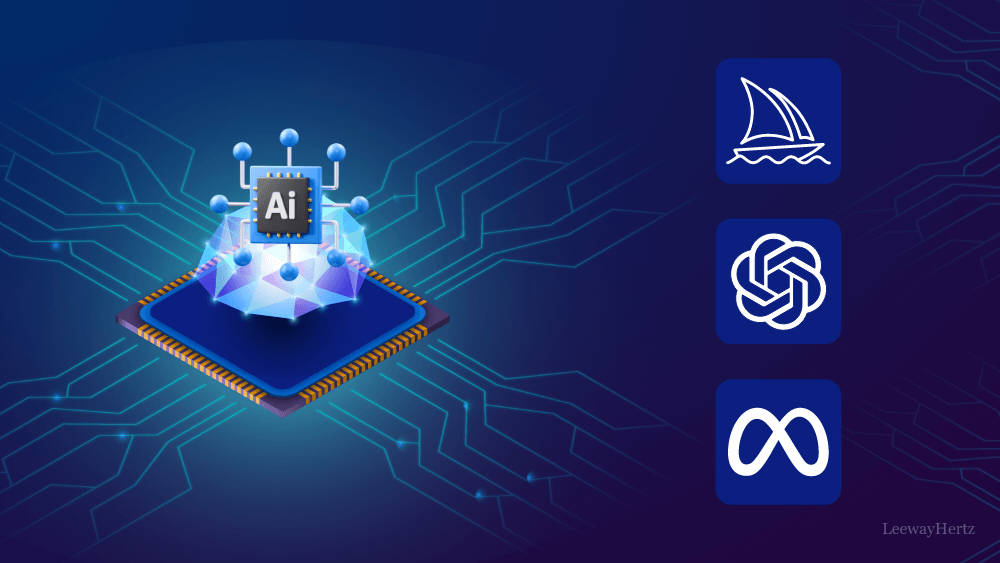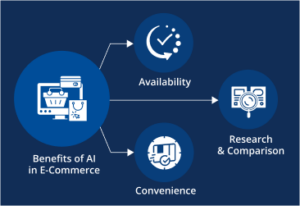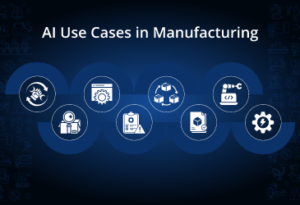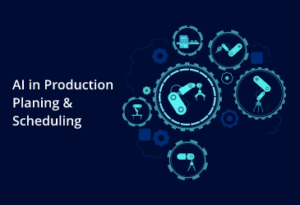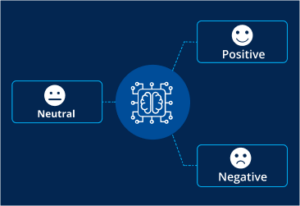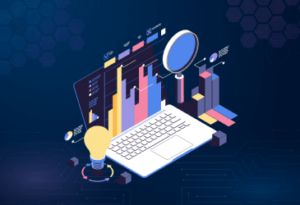AI in product development for streamlined, expedited and enhanced processes
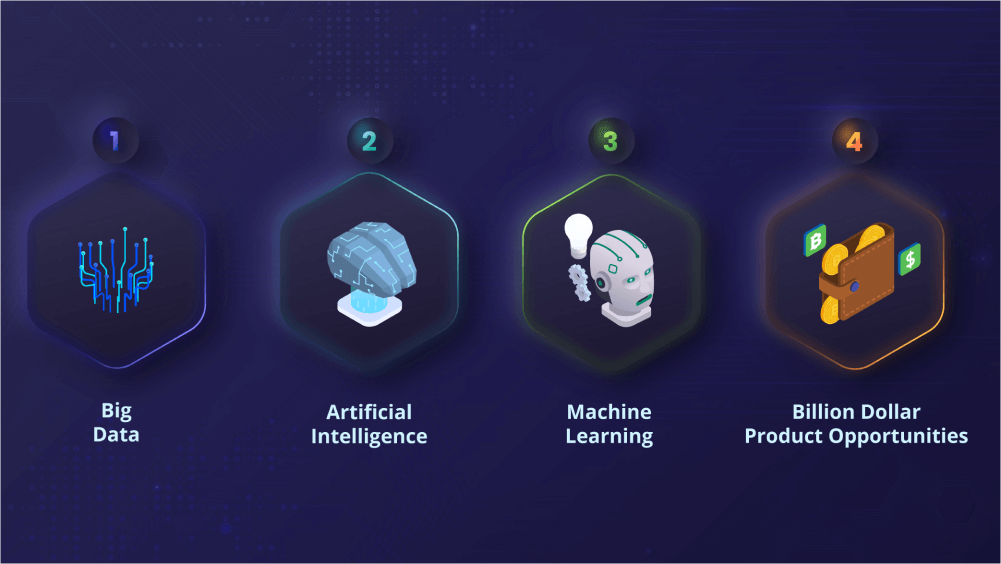
AI tools are rapidly growing in number and integrating into business operations. As reported by PwC, enterprises advanced in utilizing AI and Machine Learning (ML) in product development—termed Digital Champions—witness over 30% of their revenues generated from fully digital products or services, setting a benchmark in technological assimilation (Digital Product Development 2025, PwC, 2020). Furthermore, Digital Champions use AI and ML to improve efficiency and accelerate development timelines in areas like digital prototyping and product lifecycle management.
Within the expansive global market, AI is making significant strides, poised for substantial growth. Projections indicate that by the year 2024, AI is anticipated to elevate its market worth to an impressive half a trillion USD. This meteoric rise underscores the profound impact of AI on industries ranging from automotive and pharmaceuticals to education and manufacturing, amplifying the necessity of its integration into contemporary product development cycles.
Armed with AI, companies are witnessing significant returns on investments and enhanced efficiencies, as substantiated by a study from MarketsandMarkets projecting the AI development market to soar from $86.9 billion in 2022 to $407 billion by 2027. The symbiosis between AI and IoT platforms also heralds a new era of product development, necessitating agile adaptation to the relentless pace of technological advancements.
In this article, we delve into how AI transforms the product development process, highlighting its potent influence, strategic imperatives, and the boundless possibilities it unfolds for futuristic, efficient, and innovative product development trajectories.
- AI in product development: What does it entail?
- How does AI in product development transform the process?
- Leveraging AI across product development: Key use cases in operations
- How does LeewayHertz’s generative AI platform transform product development operations?
- How to integrate AI into your product development process?
- Benefits of AI in product development
- Legal and ethical considerations while using AI in product development
- Future trends of AI in product development
AI in product development: What does it entail?
AI has become an indispensable tool in modern product development, transforming how companies conceive, design, and bring products to market.
The initial phase of product development involves ideation and conceptualization. AI assists in market analysis, trend identification, and consumer behavior prediction through data analytics and natural language processing (NLP). By analyzing vast data from diverse sources such as social media, customer reviews, and industry reports, AI helps identify gaps in the market and provides insights into consumer preferences and demands.
During the design phase, AI enables rapid prototyping and iterative design processes. It can explore numerous design options within defined parameters and constraints, empowering engineers to enhance product performance, functionality, and manufacturability by optimizing design iterations. Moreover, AI-powered design tools can automate tedious tasks like CAD modeling, reducing design time and enhancing collaboration among cross-functional teams.
In the manufacturing phase, AI plays a crucial role in optimizing production processes and ensuring quality control. Predictive maintenance algorithms leverage AI to analyze equipment sensor data and predict potential failures before they occur, reducing downtime and maintenance costs. AI-driven quality control systems use computer vision and machine learning to inspect products for defects with high accuracy and speed, improving overall product quality.
Post-production, AI continues to provide value through personalized customer experiences and ongoing product improvement. AI-powered recommendation engines analyze user behavior and preferences to deliver personalized product recommendations, enhancing customer satisfaction and loyalty. Moreover, AI-driven analytics empower organizations to collect immediate feedback from users, pinpoint areas requiring enhancement, and iterate on product features and functionalities as needed.
Elevate Your Products with AI Expertise
Transform your product development with advanced AI solutions. Leverage our AI expertise to enhance functionality and stay ahead in the competitive market.
How does AI in product development transform the process?
The role of AI in product development is undeniably transformative. Its multifaceted applications enhance various stages of product creation, from conceptualization to deployment, ensuring the development of innovative, efficient, and market-ready products. Through AI, product development has entered a new era of excellence and innovation.
Here’s a breakdown of how AI can be integrated into each stage of the product development process:
Idea generation (Ideation)
- Market research and analysis: AI-powered tools can analyze vast data from various sources, including social media, customer reviews, surveys, and industry reports, to identify trends, preferences, and emerging needs in the target market. Natural Language Processing (NLP) algorithms can better analyze customer feedback and sentiment to understand consumer needs and pain points.
- Concept testing: AI algorithms can help in concept testing by analyzing consumer behavior data and predicting the potential success of different product concepts. A/B testing can be automated using AI to iterate and refine product ideas based on real-time feedback.
Product definition
- Competitor analysis: AI can automate gathering and analyzing data on competitors’ products, pricing strategies, and market positioning. ML models can identify patterns and trends in competitor data to refine the product strategy.
- Value proposition development: Natural Language Processing (NLP) can analyze customer reviews and feedback to identify the key pain points and preferences that the product should address. AI can also assist in generating personalized value propositions based on individual customer profiles and preferences.
Prototyping
- Feasibility analysis: AI algorithms can analyze project requirements, resource availability, and historical project data to assess the feasibility of project timelines and resource allocation. ML models can predict potential risks and bottlenecks in the development process.
- Market risk research: AI can analyze market data and trends to identify potential risks such as changes in consumer behavior, regulatory issues, or supply chain disruptions. Predictive analytics can help in proactive risk management and mitigation.
- Development strategy: AI-powered project management tools can optimize task allocation, resource scheduling, and project timelines based on historical data and real-time insights. Machine learning algorithms can identify dependencies and critical path activities to streamline the development process.
Design
- Product mockup generation: AI can assist in generating product mockups and designs based on input parameters such as target audience preferences, brand identity, and functional requirements. Generative design algorithms can explore various design options and automatically generate prototypes.
- Personalized design recommendations: AI can offer personalized design recommendations, utilizing data from customer preferences and past interactions. These recommendations may include customized interface layouts, color schemes, or feature prioritization tailored to specific user segments, ultimately enhancing engagement and satisfaction.
Validation and testing
- Automated testing: AI can help automate testing by generating test cases, executing tests, and analyzing results. Moreover, ML algorithms can identify patterns in test data to detect anomalies and performance issues more efficiently.
- Predictive analytics: AI can predict the product’s performance based on historical data and simulations. Machine learning models can forecast sales volumes, customer adoption rates, and market response to optimize resource allocation and marketing strategies.
Commercialization
- Demand forecasting: AI-powered demand forecasting models can predict future sales for the product based on historical sales data, market trends, and external factors. Machine learning algorithms can optimize inventory management and production planning to meet customer demand while minimizing inventory costs.
- Personalized marketing: AI can personalize marketing campaigns based on customer segmentation, behavior analysis, and predictive analytics. Recommendation systems can suggest personalized product recommendations and promotional offers to individual prospects, enhancing customer engagement and conversion rates.
By integrating AI into each stage of the product development process, organizations can leverage data-driven insights, automation, and predictive analytics to accelerate innovation, reduce time-to-market, and enhance the overall success of new product launches.
Leveraging AI across product development: Key use cases in operations
The use cases of AI in product development include:
Identify user needs
AI tools can identify user needs by analyzing vast data to recognize common patterns and preferences among target audiences. By leveraging machine learning algorithms, AI generates imaginative scenarios that encapsulate users’ needs and pain points, facilitating product development teams’ clear understanding. This streamlines the process of creating buyer profiles and user stories, enabling teams to focus on features that directly address the primary concerns of their target customers, ultimately leading to more effective product development strategies.
Manufacturing
The integration of AI into assembly line operations represents a manufacturing enhancement. AI swiftly identifies, diagnoses, and rectifies operational inefficiencies and bottlenecks by leveraging its profound data analysis capabilities. Through real-time analysis, AI optimizes workflows, enhances scheduling, and improves overall productivity, reducing operational costs and enhancing manufacturing outcomes. This integration of AI streamlines processes, boosts efficiency, and ensures that manufacturing operations remain competitive and agile in dynamic market environments.
Graphic designing
AI facilitates the development of user aesthetics, UI, and UX by swiftly enabling designers to generate diverse design options based on user input. AI-driven design tools analyze user data to offer suggestions rooted in trends and preferences, aiding developers in crafting more engaging user interfaces. Furthermore, these tools optimize functionality and enhance immersion by assisting in generating wireframes and high-fidelity designs tailored to user preferences and requirements. Through iterative feedback loops, AI models refine designs based on user input, ensuring the creation of user-centric interfaces that elevate the overall user experience.
Product development strategy
AI empowers businesses to make informed decisions by offering valuable insights into product development strategies. Companies can identify new opportunities, optimize product features, and align their strategies with market demand by utilizing AI algorithms to analyze market trends, customer preferences, and competitor data. This data-driven approach significantly enhances the success rate of new product launches while minimizing the risk of failure, ensuring that businesses stay competitive and responsive to evolving market dynamics.
Product design
AI has the potential to transform product design by exploring a multitude of design possibilities, enabling the creation of unique and optimized products. Additionally, AI can analyze user feedback and preferences, assisting businesses in tailoring designs to meet customer expectations and enhance the user experience. This integration of AI in product design accelerates innovation, ensures customer satisfaction, and drives competitive advantage in the market.
Product management
AI transforms product management by automating repetitive tasks, analyzing vast datasets, and offering actionable insights. This empowers product managers to make data-driven decisions across various aspects, such as demand forecasting and inventory management. AI optimizes product lifecycle management by enhancing efficiency and reducing costs, ensuring businesses stay agile and competitive in dynamic markets.
Product security
As product security rises in importance, AI provides robust solutions to safeguard against cyber threats. AI algorithms excel in detecting anomalies, identifying potential vulnerabilities, and monitoring suspicious activities. By integrating AI-driven security measures, businesses can fortify their products against unauthorized access, data breaches, and other security risks, ensuring increased protection.
Quality assurance
Quality assurance is paramount in the product development lifecycle, and AI plays a crucial role in maintaining high standards. Through automated defect detection and consistency checks, AI ensures product quality by leveraging machine learning models trained on extensive specifications and quality benchmark datasets. This enables thorough scrutiny of every aspect of a product, encompassing design and functionality, to ensure adherence to predetermined criteria before reaching the consumer. Therefore, AI-driven quality assurance enhances customer satisfaction and reinforces the brand’s reputation for reliability and excellence.
AI-powered chatbot
AI-powered chatbots can transform product development by serving as a dynamic interface between teams and customers. The chatbot can swiftly gather feedback, preferences, and suggestions from users through natural language processing capabilities, enabling real-time insights into market demands. Additionally, it can provide personalized recommendations, guiding users through product features and updates. Furthermore, the chatbot can streamline customer support by resolving queries, troubleshooting issues, and offering product-related assistance around the clock. Integrating seamlessly into the development cycle, the AI-powered chatbot enhances collaboration, accelerates decision-making, and ultimately drives innovation within the product development framework.
AI algorithms transform this process by analyzing data from the assembly line. They swiftly detect and diagnose problems like equipment malfunctions or bottlenecks, offering real-time solutions to enhance assembly line efficiency. Moreover, AI optimizes the scheduling and sequencing of assembly line tasks, leading to significant improvements in production times and cost-effectiveness. This integration of AI in assembly line operations streamlines processes boosts productivity and ultimately enhances the competitiveness of manufacturing businesses.
Elevate Your Products with AI Expertise
Transform your product development with advanced AI solutions. Leverage our AI expertise to enhance functionality and stay ahead in the competitive market.
How does LeewayHertz’s generative AI platform transform product development operations?
LeewayHertz’s generative AI platform, ZBrain, is a vital tool helping enhance and streamline various aspects of the product development process within businesses across industries. By enabling the creation of custom LLM-based applications tailored to clients’ proprietary data, ZBrain optimizes product development workflows, ensuring operational efficiency and enhanced innovation. The platform processes diverse data types, including design specifications, images, and documents, and utilizes advanced large language models like GPT-4, Vicuna, Llama 2, and GPT-NeoX to build context-aware applications that can improve decision-making, deepen insights, and boost productivity, all while maintaining strict data privacy standards, making it indispensable for modern product development operations.
In product development, challenges like evolving market demands, rapid prototyping complexities, and dynamic supply chain management are prevalent. ZBrain offers a solution to these challenges through its “Flow” feature, which provides an intuitive interface that allows users to create intricate business logic for their apps without the need for coding. Flow’s easy-to-use drag-and-drop interface enables the seamless integration of prompt templates, large language models and other generative AI models into your app’s logic for its easy conceptualization, creation, or modification.
These sophisticated apps built on ZBrain are capable of converting complex product development data into actionable insights, enhancing operational efficiency, minimizing errors, and improving product quality. For a comprehensive exploration of ZBrain’s capabilities, delve into this resource showcasing a variety of industry-specific Flow processes. This compilation underscores the platform’s robustness and versatility, illustrating how ZBrain effectively addresses diverse use cases across various industries.
How to integrate AI into your product development process?
Incorporating AI into your product development process fosters innovation, boosts efficiency, and enhances competitiveness. By conducting thorough market research, bringing together a highly skilled team, and strategically incorporating AI throughout the development process, you create the conditions for a product that aligns well with market needs, showcases innovation, and achieves market-ready excellence. Here is a step-by-step guide:
Beginning with market research
Embarking on a journey into AI-integrated product development necessitates a well-founded understanding of the current market landscape. Begin with a rigorous market research process that centers on identifying a unique product concept that resonates with unmet market needs and stands out amidst the competition. Employ analytical tools such as SWOT analysis to cultivate a deep understanding of your niche, enabling the ideation of a product that is both innovative and perfectly aligned with market demands. This process should also involve a meticulous examination of competitors, gauging how AI is being leveraged in existing products and harvesting insights into the evolving preferences and expectations of the target audience.
Curating the ideal AI development team
Building a team equipped with the necessary expertise is crucial in navigating the complexities of AI integration. Evaluate your current resources to determine whether your team possesses the requisite skills to implement sophisticated AI procedures. If there’s a deficiency in expertise, consider exploring outsourcing avenues. Collaborating with external software development companies or freelancers can be a strategic approach to supplementing your team’s capabilities. However, choose your external partners with diligence, ensuring they bring a wealth of expertise and a dedicated focus on propelling your project to success.
Outsourcing: Crafting strategic partnerships
When it comes to outsourcing, various avenues can be explored. Freelancers offer flexibility, but they might juggle multiple projects, which could affect their dedication to your endeavor. On the other hand, specialized software development companies present a rich reservoir of meticulously vetted talent. Such companies often comes equipped with experienced project managers who can steer the development process with strategic oversight, ensuring that the AI integration aligns seamlessly with your product vision and objectives.
Structuring AI integration within development stages
Decision-making regarding the stages of product development where AI will be infused is pivotal. Based on a comprehensive understanding of your market and your product’s specific needs, strategically determine the phases—from design and testing to marketing—where AI can bring transformative value. Ensure that the integration of AI technologies is executed in a manner that amplifies the product’s capabilities, optimizes processes, and enhances overall product viability and market appeal.
Benefits of AI in product development
The benefits of integrating AI in product development include the following:
Enhanced efficiency: AI technologies offer unparalleled processing capabilities, allowing businesses to examine vast amounts of data swiftly. By harnessing AI algorithms, companies can streamline various stages of product development, from ideation and prototyping to testing and optimization. Automating repetitive tasks reduces human error and accelerates time-to-market, allowing businesses to maintain agility and adaptability to changing market demands.
Data-driven decision-making: Data is the foundation of product development, and AI empowers businesses to extract valuable insights from extensive datasets. AI algorithms analyze historical product data, customer feedback, market trends, and competitor information to discern patterns and predict future trends. These data-driven insights enable informed decision-making, risk mitigation, and optimization of product development strategies to address customer needs effectively.
Improved product quality: AI technologies enhance product quality by facilitating advanced simulations, testing, and validation. AI-powered tools simulate diverse scenarios, detect potential design flaws, and optimize product performance before creating physical prototypes. This reduces the time and costs of numerous iterations, ensuring that the final product meets or surpasses customer expectations.
Personalized customer experiences: In an era of personalization, AI plays a pivotal role in comprehending customer preferences and tailoring products accordingly. By analyzing customer data, AI algorithms identify individual preferences, suggest personalized product features, and recommend complementary products. Such personalized experiences enhance customer satisfaction, foster brand loyalty, and drive repeat business.
Transformative psychometric analysis: AI powered psychometric analysis delves into user preferences and behavioral patterns, providing developers with valuable insights to tailor products accordingly. By deciphering nuanced user dynamics, AI aids in understanding the needs of target audiences, empowering developers to create more resonant and engaging products. This approach enhances user satisfaction and fosters stronger connections between users and products, ultimately driving success in the market.
Reduced cost: AI aids in reducing costs in product development by accurately predicting material requirements, minimizing waste, and optimizing energy consumption during manufacturing processes. By automating repetitive tasks, AI frees up labor resources for more strategic endeavors, maximizing efficiency.
Competitive advantage: Companies gain a significant competitive edge by integrating AI into product development. AI-driven insights enable swift adaptation to market changes, positioning the company as a frontrunner in innovation. This agility allows for the timely introduction of products that meet evolving consumer demands, outpacing competitors. Moreover, AI streamlines processes, optimizing efficiency and reducing time-to-market, giving the company a strategic advantage.
Elevate Your Products with AI Expertise
Transform your product development with advanced AI solutions. Leverage our AI expertise to enhance functionality and stay ahead in the competitive market.
Legal and ethical considerations while using AI in product development
In AI product development, a conscientious approach that prioritizes legal and ethical considerations is indispensable. By making committed efforts to address bias, safeguard privacy, clarify responsibility, and cultivate ethical awareness and guidelines, we can steer AI development toward a path that resonates with societal well-being, fairness, and ethical integrity.
Addressing bias and discrimination
AI’s increasing autonomy brings significant ethical considerations, one of which is bias and discrimination. AI models, mirroring the data they are trained on, may inadvertently perpetuate biases, leading to unequal and unjust outcomes. It is imperative to rigorously assess and cleanse training data to mitigate this, ensuring the resultant AI applications operate impartially and promote fairness across diverse societal sectors.
Privacy and surveillance concerns
The advanced data-processing capabilities of AI underscore pressing concerns regarding privacy and surveillance. AI systems can analyze vast reservoirs of sensitive and confidential information, necessitating stringent safeguards to prevent misuse or unauthorized access. Organizations must prioritize robust data protection mechanisms, ensuring that the information processed by AI systems is secure, respecting individuals’ privacy and upholding ethical standards.
Responsibility and oversight
As artificial intelligence continues to advance, it becomes increasingly essential to address accountability for its actions. Given that AI can operate independently, identifying clear responsibility is crucial. Establishing robust guidelines and mechanisms is necessary to ensure AI’s safe and ethical use, thereby mitigating potential risks and negative impacts.
AI’s role in human judgment and decision-making
The increasing role of AI in fields like recruitment and medical diagnosis raises important ethical questions. We must carefully consider how AI should complement human judgment to improve decision-making while respecting the integrity and discretion of human involvement. This involves striking a balance between leveraging AI’s capabilities and preserving the essential role of human oversight and decision-making authority.
Creating ethical guidelines and promoting dialogue
Organizations play a crucial role in fostering ethical AI environments. This involves establishing clear guidelines that prioritize ethical AI practices, including measures to identify and eliminate biases. Engaging in ongoing dialogues with society about the ethical implications of AI is equally important. By promoting collective awareness and seeking meaningful solutions, organizations can contribute to building an ethical framework for AI that benefits everyone.
Fostering research and education
Investments in research and education are paramount in navigating AI’s ethical landscapes. These efforts facilitate a deeper understanding of potential risks and ethical quandaries, empowering stakeholders to develop AI technologies that resonate with integrity, consideration, and human-centric values.
Future trends of AI in product development
As we navigate the future of product development, a panorama of AI-driven trends emerges, each promising transformative impact. In the realm of product development, the future of Artificial Intelligence (AI) promises to introduce several transformative trends, which include:
- Multidimensional printing: Multidimensional printing emerges as a transformative trend poised to redefine the contours of design and creativity processes. This technology promises a realm where virtual creations transcend into tangible realities, fueling the mass production of multifaceted objects and products. Such advancements in printing technologies herald a future where creativity meets unprecedented possibilities, unfolding new dimensions in product development.
- Generative AI for design innovation: Integrating generative AI algorithms into the creative process can allow for the autonomous generation of innovative designs. This advancement will broaden design possibilities, transforming traditional approaches to product creation.
- Explainable AI (XAI) adoption: Expect a surge in the adoption of Explainable AI, particularly in industries with strict regulatory requirements. XAI will offer enhanced transparency by enabling stakeholders to interpret complex AI decision-making processes, fostering trust and understanding.
- AI-driven rapid prototyping: Leveraging AI-driven simulations will expedite prototyping in product development, facilitating swift design refinement and slashing time-to-market. This streamlined process promises a competitive advantage by accelerating innovation and product launch timelines.
- Edge AI: Embrace the widespread adoption of Edge AI, which brings AI processing closer to data sources. This advancement enables real-time data processing and enhances responsiveness in product development, particularly in scenarios where latency is a critical factor.
These trends collectively represent a paradigm shift in product development driven by AI’s transformative potential. By leveraging these advancements, businesses can unlock new avenues for innovation, streamline processes, and deliver unparalleled value to customers in an increasingly dynamic marketplace.
Endnote
The integration of AI in product development has emerged as a transformative force, redefining how businesses innovate, design, and bring products to market. AI’s profound impact is evident across various stages of the product development lifecycle, from ideation and prototyping to manufacturing and post-launch optimization.
AI expedites the product development process and enhances its efficiency by providing valuable insights, predicting market trends, and optimizing resource allocation. The ability of AI algorithms to analyze vast amounts of data in real-time allows businesses to make data-driven decisions, ultimately leading to more informed and successful product development strategies.
Furthermore, the collaborative nature of AI, when combined with human creativity and expertise, fosters a synergy that results in breakthrough innovations. The iterative nature of AI-powered design allows for continuous improvement and adaptation, ensuring that products remain competitive in dynamic markets.
However, as we embrace the potential of AI in product development, it is crucial to navigate ethical considerations and address concerns related to privacy, bias, and accountability. Striking a balance between technological advancement and ethical responsibility will be key to ensuring the widespread acceptance and sustainable growth of AI in this domain.
In the coming years, the evolution of AI technologies will likely bring about even more sophisticated tools and capabilities, shaping the future of product development. As businesses continue to explore and harness the potential of AI, they will undoubtedly redefine industry standards, create new possibilities, and pave the way for a future where innovation knows no bounds. As we stand at the intersection of human ingenuity and artificial intelligence, the collaboration between man and machine promises to unlock unprecedented potential, ushering in an era of unparalleled progress and innovation in product development.
Propel your business into an era of innovation and excellence with robust products. Join forces with LeewayHertz to experience a product development journey like never before – streamlined, fast-tracked, and enriched by the pervasive integration of AI!
Start a conversation by filling the form
All information will be kept confidential.





